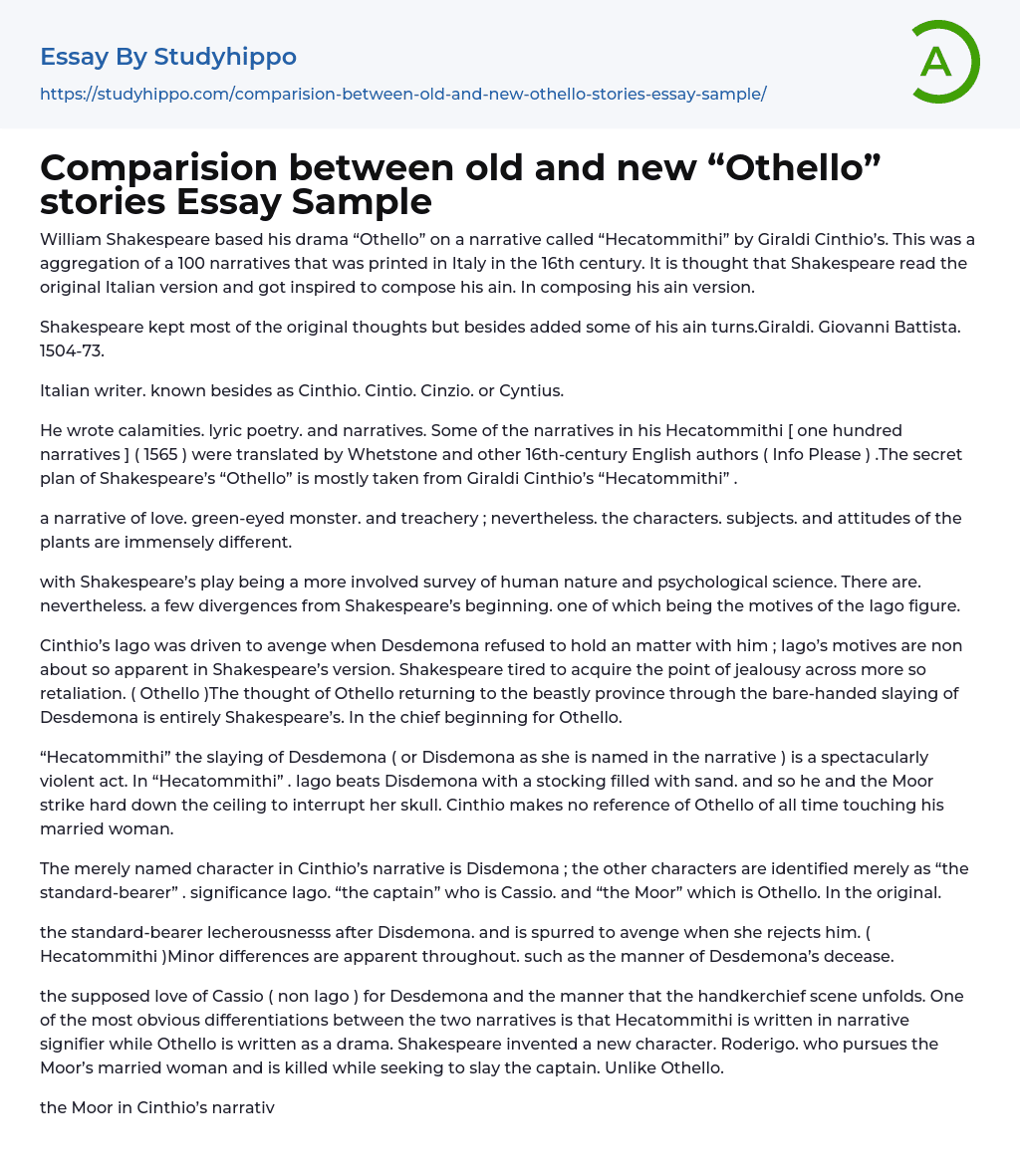William Shakespeare's play "Othello" was inspired by Giraldi Cinthio's collection of 100 narratives, "Hecatommithi", which was published in 16th century Italy. It is believed that Shakespeare read the original Italian version and was inspired to create his own rendition.
While maintaining the majority of the original ideas, Shakespeare also incorporated some of his own alterations according to Giraldi, Giovanni Battista (1504-73).
This Italian author is also referred to as Cinthio, Cintio, Cinzio, or Cyntius.
He authored calamities, lyric poetry, and narratives, including his Hecatommithi [one hundred narratives] (1565), of which some were translated by 16th-century English writers such as Whetstone (Info Please). Shakespeare's "Othello" is largely based on the plot of Giraldi Cinthio's "Hecatommithi".
A story about love, jealousy, and betrayal; however, the plants' characters, subjects, and attitudes are vastly diverse.
D
...espite a few deviations from Shakespeare's original work, such as the motives of the Iago figure, his play delves deeper into the study of human nature and psychology.
Cinthio's portrayal of Iago involved seeking revenge after Desdemona rejected him, whereas Shakespeare focused more on depicting jealousy and revenge in Othello. Shakespeare added the concept of Othello returning to a bestial state and killing Desdemona with his own hands. These ideas originated from Shakespeare's primary source for Othello.
According to "Hecatommithi", the killing of Disdemona (also known as Desdemona in the narration) is an incredibly violent event. Iago uses a sand-filled stocking to beat Disdemona, while the Moor and he strike her skull so hard that the ceiling is disrupted. Cinthio never mentions Othello ever laying a hand on his wife.
In Cinthio's narrative, Disdemona is the only character who is named, while the rest are identified only by their role
such as "the standard-bearer" for significance Iago, "the captain" for Cassio, and "the Moor" for Othello. This is how they are presented in the original text.
In Hecatommithi, the protagonist's lust for Desdemona leads him to seek revenge when she rejects him. Although there are minor differences, such as the way Desdemona dies, these deviations from the standard narrative are noticeable.
In comparing Hecatommithi and Othello, one difference is the format - Hecatommithi is written in narrative form while Othello is a play. Additionally, Shakespeare created the character of Roderigo, who chases after Othello's wife and dies in an attempt to kill the captain. This is unlike the Hecatommithi narrative, which features Cassio (not Iago) supposedly loving Desdemona and the unfolding of the handkerchief scene.
In Cinthio's narration, the Moor never regrets killing his wife and, together with the standard-bearer, they flee from Venice and are eventually killed. Cinthio also has a moral lesson that European women should not marry men from other countries who are known to be hot-tempered and difficult to manage. However, Shakespeare decides not to incorporate this idea into his adaptation.
(Hecatommithi) In Shakespeare's interpretation, Iago has a strong sexual fixation, while Othello exhibits sexual restraint. Meanwhile, Cassio is portrayed as a womanizer. Shakespeare emphasizes the importance of Othello's race more than Cinthio. Additionally, Shakespeare's version is more creative in exploring Othello's foreign background and complex human emotions that are exposed throughout the play.
Cinthio's rendition can be described as "shallow", in comparison to Shakespeare's work which engages the reader with each character on a deeper level. Othello, unlike Cinthio's version, delves into the theme of jealousy.
The gradual destruction of a human mind due to
treachery, unsighted fury, and bitterness is explored in Shakespeare's Othello. The play reveals an alien past for the protagonist and the significance of the hankie. Othello is portrayed as both a romantic and a faithful military man. Shakespeare's work demonstrates his faithfulness and superiority as a writer.
Shakespeare added a personal and profound touch to the original narrative of Hecatommithi while preserving its main message. Unlike the original version, where the protagonist remains anonymous, he gave each character a unique physical and psychological identity.
- Othello Jealousy essays
- 1984 essays
- A Farewell to Arms essays
- A Good Man Is Hard to Find essays
- A Hanging essays
- A Lesson Before Dying essays
- A Long Way Gone essays
- A Rose For Emily essays
- A Separate Peace essays
- A Tale Of Two Cities essays
- A Very Old Man With Enormous Wings essays
- Adventures Of Huckleberry Finn essays
- Alice in Wonderland essays
- All Quiet on The Western Front essays
- Allegory of the Cave essays
- An occurrence at owl creek bridge essays
- Animal Farm essays
- Anthem essays
- Antigone essays
- Arthur Conan Doyle essays
- As I Lay Dying essays
- Atticus Finch essays
- Barn Burning essays
- Battle Royal essays
- Beauty and The Beast essays
- Beloved essays
- Boo Radley essays
- Brave New World essays
- Candide essays
- Castle essays
- Characters In Hamlet essays
- Characters In Romeo And Juliet essays
- Christmas carol essays
- Chronicle of a Death Foretold essays
- Cinderella essays
- Crime and Punishment essays
- Daisy Miller essays
- Death of a Salesman American Dream essays
- Desdemona essays
- Diary Of A Wimpy Kid essays
- Dracula essays
- Dubliners essays
- Emma essays
- Ender'S Game essays
- Ethan Frome essays
- Eveline essays
- Fahrenheit 451 essays
- First-Person Narrative essays
- Fish Cheeks essays
- Frankenstein essays




